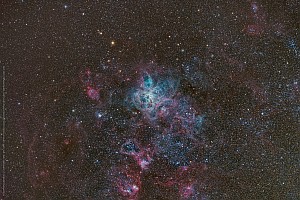Large Magellanic Cloud is the topic of Part #4 of our image presentation, where we want to share the results from our astrophotography-trip to the Hacienda Los Andes in Chile.
The Large Magellanic Cloud (LMC) is a nearby galaxy, and a satellite of the Milky Way. At a distance of approximately 163,000 light-years the LMC is the third closest galaxy to the Milky Way. The LMC has a diameter of about 14,000 light-years and a mass of approximately 10 billion Sun masses. There are a lot of spectacular deepsky objects within and all around the LMC, which we will take a closer look at with the following images.
NGC 1763 is a bright emission neula embedded in the LMC and is part of the nebula complex N11, a young star forming region. Massive star formation is also going on in the HII complex N44 in which the open star cluster NGC 1929 is embeded. Massive stars in the cluster produce intense radiation, expel matter at high speeds and explode relatively quickly as supernovas. Winds from the massive stars and shocks from the supernovas carve out "superbubbles" in the gas of N44, which can be easily seen in our images. Because of these "bubbles" N44 is also known as the superbubble complex.
When it comes to NGC 2070, literature could be quite confusing, because mostly NGC 2070 refers to the Tarantula Nebula, but you will also find the information that NGC 2070 is a cluster or open cluster. On the other hand the Tarantula Nebula is also known as 30 Doradus, which refers to a star. So what? It's necessary to tell the whole story to get it all sorted out: In the early days, when astronomers looked up in the sky (towards the Tarantula Nebula), they could only see a bright spot, so the Tarantula Nebula was first cataloged as a star: 30 Doradus. Later on the Tarantula Nebula was recognized to be a nebula by Nicholas Louis de Lacaille in 1751.
But this is only half of the story. What we call Tarantula Nebula today is a large emission nebula (a giant HII region) which surrounds a star cluster (R136) which produces most of the energy that makes the Tarantula Nebula visible. R136 is one of the most energetic star clusters known. It contains several extremely huge stars, roughly 100 times the mass of the Sun. The cluster has an estimated mass of 450,000 solar masses and a diameter of 35 light years. R136 also contains R136a1, a Wolf-Rayet star which is the most massive and also one of the hottest stars known today.
The Tarantula Nebula is so huge, if it would be closer to the earth, say like the distance of the well known Orion Nebula, it would take up half the sky!
Finally another gorgeous video from our timelapse photographer Justin Kabaus, showing the Small and the Large Magellanic Cloud passing by.









